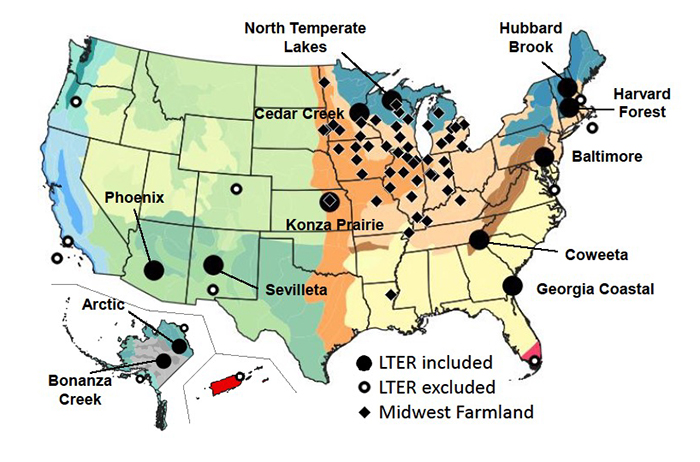
Filled black circles represent LTER sites with arthropod data that were included in the study. Colors on the underlying map delineate ecoregions as defined by the USDA Forest Service.
CONWAY, Ark. (August
11, 2020) — For years now, scientists have warned of a coming “insect
apocalypse” that threatens to wipe out many arthropod species, bringing
significant ecological ramifications, including adverse effects on food
production for human and other animal populations. But exactly what changes are
we seeing in the United States? At this point, the declines do not appear to be
as widespread as feared, according to a new study recently published in Nature
Ecology and Evolution.
Hendrix College’s
Elbert L. Fausett Distinguished Professor of Biology Matthew
D. Moran and University of Georgia Professor of Agroecology Bill Snyder
collaborated on the study with lead author Michael S. Crossley, a postdoctoral
researcher in the UGA Department of Entomology. Numerous undergraduates from
Hendrix, postdoctoral researchers Crossley and Amanda R. Meier from UGA, and
other researchers from the USDA participated in the data analysis. Emily M.
Baldwin, Lauren L. Berry, Leah C. Crenshaw, David H. Nichols, Krishna Patel, and Sofia Varriano formed
the team of Hendrix College student researchers for the project.
The idea for the
study stemmed from a conversation between Snyder and Moran, who attended
college together and over the years have maintained their friendship and
pursued similar research interests. In their discussion, they recalled the U.S.
National Science Foundation’s network of Long-Term Ecological Research (LTER)
sites established in 1980. They posited that examining four decades of data gathered
by this network of 25 monitoring locations across the country could yield significant
findings.
“We thought the
LTER data would be ideal for asking this type of question,” Moran said. “These
study sites were set up in the 1980s to monitor and study ecological processes
across the United States. If, indeed, insect declines had occurred during this
time frame, those monitoring efforts should have detected it.”
The research team
analyzed publicly available databases in the NSF’s LTER network, marking the
first time such information has been gathered into a single dataset to be
examined for evidence of broad-scale density and changes in biodiversity over time.
While some species
and geographical areas showed marked increases or decreases in abundance and
diversity, many remained steady, resulting in very little net change in insect population
trends nationwide. This lack of overall increase or decline was consistent
across arthropod feeding groups, and similar for heavily disturbed versus
relatively natural sites.
“No matter what
factor we looked at, nothing could explain the trends in a satisfactory way,”
said Crossley, the lead author of the study. “We just took all the data and,
when you look, there are as many things going up as going down. Even when we
broke it out in functional groups there wasn’t really a clear story like
predators are decreasing or herbivores are increasing.”
Arthropod data
sampled by the team included grasshoppers in the Konza Prairie in Kansas;
ground arthropods in the Sevilleta desert/grassland in New Mexico; mosquito
larvae in Baltimore, Maryland; macroinvertebrates and crayfish in North
Temperate Lakes in Wisconsin; aphids in the Midwestern U.S.; crab burrows in
Georgia coastal ecosystems; ticks in Harvard Forest in Massachusetts; caterpillars
in Hubbard Brook in New Hampshire; arthropods in Phoenix, Arizona; and stream
insects in the Arctic in Alaska.
Snyder points out
that individual efforts at conservation may be creating ecological improvements
that have a broader influence.
“It’s hard to
tell when you’re a single homeowner if you’re having an effect when you plant
more flowers in your garden,” he said. “Maybe some of these things we’re doing
are starting to have a beneficial impact. This could be a bit of a hopeful
message that things that people are doing to protect bees, butterflies, and
other insects are actually working.”
About Hendrix College
A private liberal
arts college in Conway, Arkansas, Hendrix College consistently earns
recognition as one of the country’s leading liberal arts institutions, and is
featured in Colleges
That Change Lives: 40 Schools That Will Change the Way You Think About
Colleges.
Its academic quality and rigor, innovation, and value have established Hendrix
as a fixture in numerous college guides, lists, and rankings. Founded in 1876,
Hendrix has been affiliated with the United Methodist Church since 1884. To
learn more, visit www.hendrix.edu.